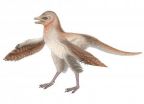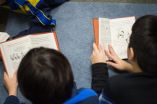(Press-News.org) The discovery of a new bird-like dinosaur from the Jurassic period challenges widely accepted theories on the origin of flight.
Co-authored by Dr Gareth Dyke, Senior Lecturer in Vertebrate Palaeontology at the University of Southampton, the paper describes a new feathered dinosaur about 30 cm in length which pre-dates bird-like dinosaurs that birds were long thought to have evolved from.
Over many years, it has become accepted among palaeontologists that birds evolved from a group of dinosaurs called theropods from the Early Cretaceous period of Earth's history, around 120-130 million years ago. Recent discoveries of feathered dinosaurs from the older Middle-Late Jurassic period have reinforced this theory.
The new 'bird-dinosaur' Eosinopteryx described in Nature Communications this week provides additional evidence to this effect.
"This discovery sheds further doubt on the theory that the famous fossil Archaeopteryx – or "first bird" as it is sometimes referred to – was pivotal in the evolution of modern birds," says Dr Dyke, who is based at the National Oceanography Centre, Southampton.
"Our findings suggest that the origin of flight was much more complex than previously thought."
The fossilised remains found in north-eastern China indicate that, while feathered, this was a flightless dinosaur, because of its small wingspan and a bone structure that would have restricted its ability to flap its wings.
The dinosaur also had toes suited to walking along the ground and fewer feathers on its tail and lower legs, which would have made it easier to run.
INFORMATION:
Dr Gareth Dyke is also Programme Leader for a new one-year MRes in Vertebrate Palaeontology, which offers potential students the chance to study the evolution and anatomy of vertebrates, in order to inform and increase our understanding of the workings of modern day creatures.
For more information about the course, please visit: http://www.southampton.ac.uk/oes/postgraduate/taught_courses/mres_in_vertebrate_palaeontology.page
New dinosaur fossil challenges bird evolution theory
2013-01-24
ELSE PRESS RELEASES FROM THIS DATE:
Sun shoots out 2 coronal mass ejections
2013-01-24
VIDEO:
This movie shows two coronal mass ejections (CMEs) erupting from the sun on Jan. 23, 2013. The first was not directed at Earth; the second one is, but is not...
Click here for more information.
On Jan. 23, 2013, at 9:55 a.m. EST, the sun erupted with an Earth-directed coronal mass ejection, or CME. Experimental NASA research models, based on observations from the Solar Terrestrial Relations Observatory (STEREO) and ESA/NASA's Solar and Heliospheric Observatory, show ...
Valuing nature is not enough
2013-01-24
Is it possible to put a price tag on the natural world? A researcher at The University of Nottingham has been examining the rise of a new concept — ecosystem services — to describe the multitude of resources supplied to us by Mother Nature.
Academic Dr Marion Potschin, of the University's Centre for Environmental Management, is among an international team of researchers who have been investigating the ethical considerations of this new concept, which some have argued turns nature into a 'commodity'.
In a paper published in the journal BioScience, Dr Potschin and her ...
Cells 'flock' to heal wounds
2013-01-24
Like flocks of birds, cells coordinate their motions as they race to cover and ultimately heal wounds to the skin. How that happens is a little less of a mystery today.
Researchers once thought only the cells at the edge of a growing patch of wounded skin were actively moving while dividing cells passively filled in the middle. But that's only part of the picture. Rice University physicist Herbert Levine and his colleagues have discovered that the process works much more efficiently if highly activated cells in every part of the patch exert force as they pull their neighbors ...
UCI neuroscientists create fiber-optic method of arresting epileptic seizures
2013-01-24
Irvine, Calif., Jan. 24, 2013 — UC Irvine neuroscientists have developed a way to stop epileptic seizures with fiber-optic light signals, heralding a novel opportunity to treat the most severe manifestations of the brain disorder.
Using a mouse model of temporal lobe epilepsy, Ivan Soltesz, Chancellor's Professor and chair of anatomy & neurobiology, and colleagues created an EEG-based computer system that activates hair-thin optical strands implanted in the brain when it detects a real-time seizure.
These fibers subsequently "turn on" specially expressed, light-sensitive ...
Mouse menopause model sheds light on UTIs in post-menopausal women
2013-01-24
Researchers from Washington University School of Medicine, St. Louis, show that reservoirs of uropathogenic E. coli within the bladder exist in higher numbers post-menopause than pre-menopause in a mouse model, a finding that could help explain the greater prevalence of urinary tract infections in post-menopausal women. They also found that estrogen supplementation reduced the numbers of such reservoirs dramatically. The research was published online ahead of print in the journal Infection and Immunity.
Urinary tract infections (UTIs) afflict an estimated 13 million ...
Vocabulary instruction failing US students
2013-01-24
EAST LANSING, Mich. — Vocabulary instruction in the early years is not challenging enough to prepare students for long-term reading comprehension, argues a study led by a Michigan State University education researcher.
The study, which appears in Elementary School Journal, analyzed commonly used reading curricula in U.S. kindergarten classrooms. It found that, generally, the programs do not teach enough vocabulary words; the words aren't challenging enough; and not enough focus is given to make sure students understand the meaning of the words.
"Vocabulary instruction ...
Research: Lupus drugs carry no significant cancer risk for patients
2013-01-24
This press release is available in French.
Montreal, January 24, 2013 – People who take immunosuppressive drugs to treat lupus do not necessarily increase their cancer risk according to new research led by scientists at the Research Institute of the McGill University Health Centre (RI-MUHC). This landmark study, which was published in Annals of the Rheumatic Diseases this month, addresses long-standing fears of a link between lupus medication and cancer.
Systemic lupus erythematosus (SLE), commonly known as lupus, is an autoimmune disease in which the body's immune ...
Female mice exposed to BPA by mothers show unexpected characteristics
2013-01-24
ANN ARBOR—Female mice exposed to Bisphenol A through their mother's diet during gestation and lactation were found to be hyperactive, exhibit spontaneous activity and had leaner body mass than those not exposed to the chemical, researchers at the University of Michigan School of Public Health have discovered.
BPA is a chemical most commonly found in the lining of food cans and cash register receipts. It once was in many hard plastic bottles, including baby bottles, but many companies have removed it as concerns about exposure have come to light in recent years.
These ...
Abuse during childhood linked to uterine fibroids in African-American women
2013-01-24
(Boston) – According to a new study from the Slone Epidemiology Center (SEC) at Boston University, African-American women who reported sexual or physical abuse before age 11 had a greater risk of uterine fibroids in adulthood compared with women who had no such abuse history. The association was strongest for women who experienced sexual abuse.
The study, which is published online in the American Journal of Obstetrics and Gynecology, was led by Lauren A. Wise, ScD, senior epidemiologist at SEC and associate professor of epidemiology at the Boston University School of ...
Greenland ice cores provide vision of the future
2013-01-24
Ice cores drilled in the Greenland ice sheet, recounting the history of the last great warming period more than 120,000 years ago, are giving scientists their clearest insight to a world that was warmer than today.
In a paper published today in the journal Nature, scientists have used a 2,540 metre long Greenland ice core to reach back to the Eemian period 115-130 thousand years ago and reconstruct the Greenland temperature and ice sheet extent back through the last interglacial. This period is likely to be comparable in several ways to climatic conditions in the future, ...



